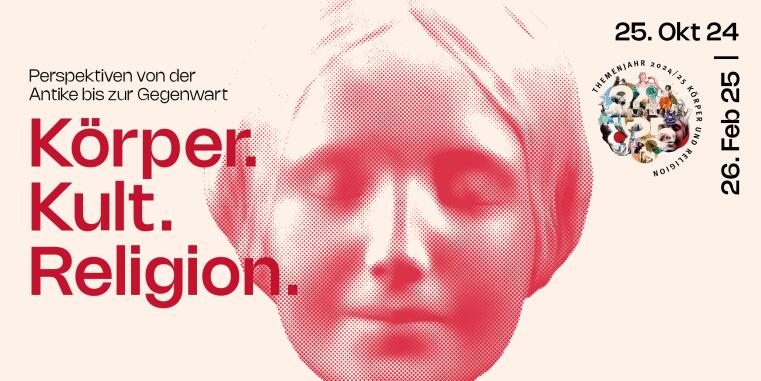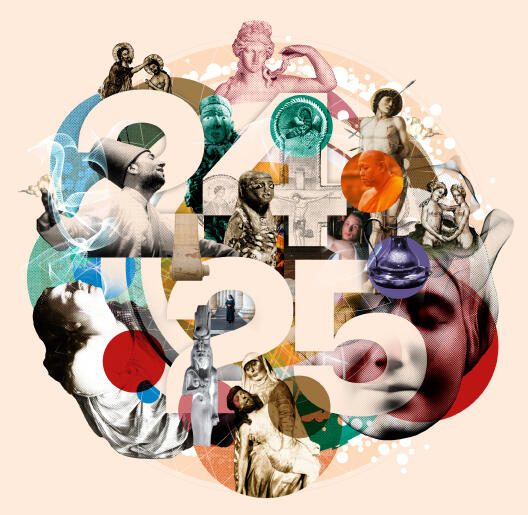
Body. Cult. Religion. Perspectives from antiquity to the present
Exhibition of the Cluster of Excellence "Religion and Politics" on the body in world religions - 2024/2025 in the Archaeological Museum and the Bible Museum of the University of Münster

To mark the start of the annual theme “Body and Religion”, the Cluster of Excellence “Religion and Politics” is opening the interdisciplinary exhibition “Body. Cult. Religion. Perspectives from antiquity to the present” at the University of Münster’s Archaeological Museum and Bible Museum on 25 October 2024. “The exhibition views the human body as both object and expression of religious ideas”, explains Egyptologist Prof. Dr. Angelika Lohwasser, who is coordinating the annual theme and organizing the exhibition with the museum directors, as well as with archaeologist Prof. Dr. Achim Lichtenberger and theologian Prof. Dr. Holger Strutwolf from the Cluster of Excellence. “Whether healing and purification rituals, asceticism and fasting, head coverings and tattoos, or practices involving the dead body – religious ideas about people, gods and otherworldly realms are reflected in our treatment of the human body across epochs and cultures”.
As archaeologist Prof. Dr. Achim Lichtenberger explains, the exhibition presents important exhibits from, for example, the Louvre in Paris, the Staatliche Museen zu Berlin, the Kunsthistorisches Museum in Vienna, the Fundação Pierre Verger in Salvador, and museums in the region. The objects range from the ancient statuette of the Roman god Hermaphroditus and ritual objects such as a nail fetish from the Congo, to replicas of famous pieces such as the death mask of the Unknown Woman of the Seine, as well as animated and documentary films about religious clothing.
The exhibition draws on the findings of the Cluster of Excellence’s interreligious, transepochal and interdisciplinary research on the relationship between religion and the body, and involves many disciplines: for example, ancient studies (Assyriology, Near Eastern archaeology, Egyptology, classical and Christian archaeology), Jewish studies, Arabic studies, Christian and Islamic theologies, religious and social sciences, sinology, and anthropology, as well as the University of Münster’s Brazil Centre.
Exhibition opening and programme of events
The exhibition and the annual theme will be officially opened in the Fürstenberghaus, Room F2 (Domplatz 20–22, 48143 Münster), on 25 October 2024 at 6 pm. Welcome addresses will be given by the rector of the University of Münster, Prof. Dr. Johannes Wessels, the mayor of the city of Münster, Angela Stähler, the speaker of the Cluster of Excellence “Religion and Politics”, Prof. Dr. Michael Seewald, and the exhibition organizers.
“The exhibition explores how religious practices and traditions shape and influence the human body”, explains archaeologist Achim Lichtenberger. “While a person’s spirit, faith and thoughts are invisible, the material body can become their visible manifestation. The exhibition is accompanied by a diverse programme of events during the annual theme that offer the general public further insights into the relationships between the body and religious ideas about the body in the past and present”. Guided tours of the exhibition with the curators, “walks and talks”, as well as panel discussions, lectures and films – these invite visitors to think about and discuss issues covered by the exhibition and their presentation in a museum, as well as current issues to do with body and spirituality, and religious clothing in the public space.
The exhibitions thematic areas
The exhibition is divided into seven thematic areas, as theologian Holger Strutwolf explains. The Archaeological Museum is presenting the areas “Divine figures”, “Gender roles?”, “Religion and healing”, and “After death”, which deal with the bodily representation of the divine, the treatment of gender roles, religious healing rituals, and the treatment of the dead body in past and present religions. The Bible Museum is covering the areas “Rituals of life”, “Purity for mind and body” and “Disembodiment”, these dealing with initiation rituals, purification rites and the relationship between mind and body in the world’s religions.

The annual theme "Body and Religion"
With the exhibition, the annual theme presents an extensive programme of lectures, panel discussions, films, guided tours, readings, and talks on current research in the Cluster of Excellence, and provides researchers and the general public with a space for discussion.
The second half of the annual theme will look at the body from a new perspective: researchers from the Cluster of Excellence and international guests will explore the aesthetic conceptions of the body in literature and the visual arts in lectures and readings during the summer term of 2025. “Ideas about the human body are not naturally given; rather, they are historical, social and cultural constructs”, explains art historian Eva Krems. “Religious rituals and ideas, legal and political regulations, medical rules and hygienic practices – these shape the body through language, image and power. In literature and the visual arts, the exposed body manifests the often conflictual or violent interplay between individual and society – be it in the form of martyred and sacralized bodies, in deformed or beautiful, flawless bodies”. The Hans Blumenberg Professorship of the Cluster of Excellence will also explore the relationship between the body and religion: Deborah Kapchan, anthropologist and professor of performance studies at New York University Tisch School of the Arts, will be a guest in Münster in the 2025 summer term, and will talk about her research on rituals of spirit possession in Morocco.
Funding
The exhibition is financed by funds from the Cluster of Excellence "Religion and Politics" and the Rectorate of the University of Münster as well as funding from the Kulturstiftung der Länder.

